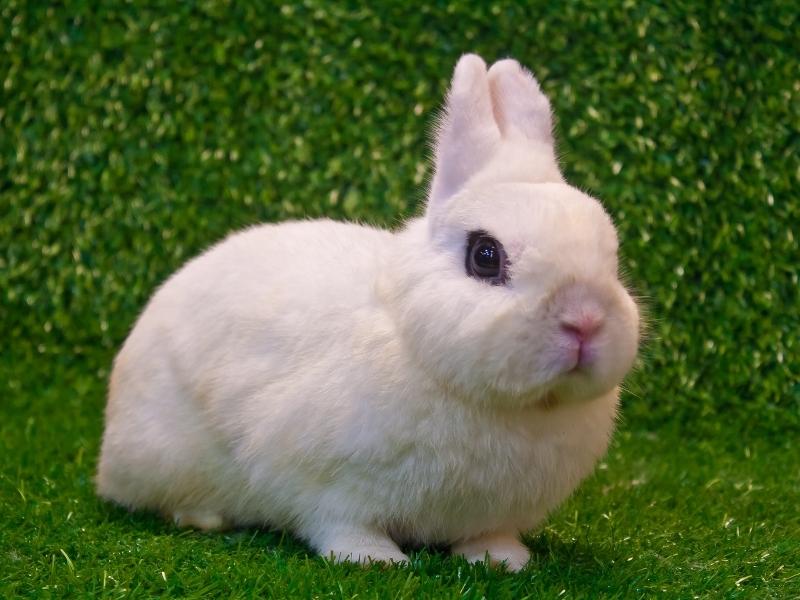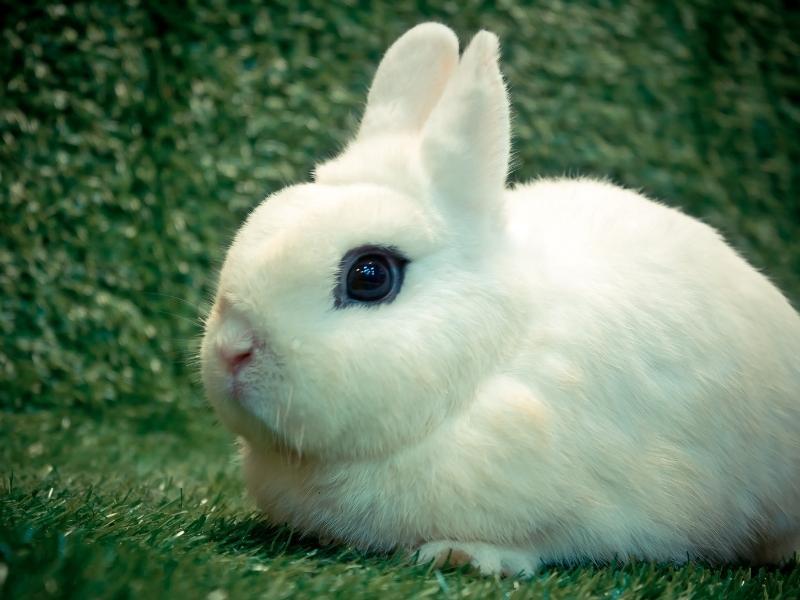Looking for a large-sized rabbit breed that is all white and cute? How about a rabbit that’s also friendly, sweet, and active? Why not consider adopting a Blanc de Hotot rabbit? It’s one of the rabbit breeds that are currently endangered.
A Blanc de Hotot rabbit is a large-sized rabbit breed that hails from France. The Blanc de Hotot rabbits have all-white rollback fur and dark brown eyes. The rabbit has black bands like eyeliner around its eyes. Blanc de Hotots are easy to care for with their active but docile personalities.
Ready to learn more about the Blanc de Hotot, where the rabbit breed originated from, what they look like, and how you can best care for them?
What Is a Blanc de Hotot Rabbit?
A Blanc de Hotot (pronounced blonk deh oh-toe), which means White of Hotot, is a rabbit breed that has a commercial-shaped body. On average, these rabbits weigh between 8 and 11 pounds and they live for 7 to 10 years.
Blanc de Hotots are ideal for first-time rabbit owners, senior citizens, and people who are single, married, or have kids. These rabbits can live indoors or outdoors.
Comparable rabbit breeds for the Blanc de Hotot rabbit are the White Vienna rabbit and the Checkered Giant Rabbit.
Blanc de Hotot Rabbit History and Origin
The Blanc de Hotot rabbit’s origins can be traced back to Hotot-en-Auge in Normandy, northern France. Eugenie Bernhard, châtelaine du Calvados, is credited with the breed’s development. Eugenie is the second woman in the world to create a new rabbit breed.
Eugenie had a large rabbitry of Géant Noir de Hotot rabbits, Flemish Giant rabbits, and Géant Papillon Français (or Checkered Giant) rabbits.
The breeding goals for the Blanc de Hotot rabbits were to develop a rabbit breed whose meat could be used for meat production and whose fur could be used for trade and the making of clothes. Eugenie also wanted the breed to be all white and have “black eyes.”
Somewhere around 1902, Eugenie cross-bred a Checkered Giant rabbit with a White Vienna and While Flemish Giant rabbit. Unfortunately, she didn’t enjoy further progress to develop the Blanc de Hotot rabbit breed at that point.
She kept the lightly marked rabbits that were kindled from 500 crosses and bred these rabbits with each other. In 1912, she got the result she wanted – the Blanc de Hotot rabbit.
In 1920, the Blanc de Hotot rabbit breed was shown at the Exposition Internationale d’Aviculture in Paris. The breed was called the Géant Blanc de Hotot, or Giant Blanc de Hotot rabbit. On October 13, 1922, the rabbit governing body in France recognized this breed.
However, the first French standard didn’t make note of eye bands on the Blanc de Hotot rabbit. These rabbits had gray lower eyelids and black eyelashes.
Somewhere between 1921 and 1922, the Blanc de Hotot rabbits were imported to the United States. Sadly, these rabbits soon died out.
In 1927, these rabbits were imported to Switzerland, and the Swiss loved the eye markings.
But during World War II, these Blanc de Hotot rabbits became nearly extinct in Germany, Holland, and France. While the Blanc de Hotot breed isn’t very popular in Europe, in 2010, there were 111 Blanc de Hotot rabbit breeders in France, so the rabbit population is increasing.
In 1978, Bob Whitman who lived in Texas imported 8 of these rabbits from France. On March 5, 1979, the American Rabbit Breeders Association recognized the Blanc de Hotot rabbit breed.
The gene pool for this rabbit was small and the body type needed to be improved. So the Blanc de Hotot rabbit was crossbred with White Satin rabbits, White New Zealand rabbits, and Blue-Eyed White Beveren rabbits.
In 2004, more Blanc de Hotot rabbits were imported into the United States from the United Kingdom, Germany, and Holland.
However, the breed is a globally endangered rabbit breed and listed as “critical” by the Livestock Conservancy. In general, there are fewer than 50 annual registrations of the Blanc de Hotot rabbit breed in the U.S. and there are fewer than 500 Blanc de Hotot rabbits in the world.
Blanc de Hotot Rabbit Characteristics

It’s quite easy to identify a Blanc de Hotot rabbit with its white fur and black eyeliner. But let’s be more specific and get into the details of this breed’s personality, body shape, and coat.
Temperament
A Blanc de Hotot rabbit is a friendly and sweet rabbit. This is part of the reason why these rabbits make great pets, whether you will be looking after your first-ever pet rabbit or have an experienced hand in raising these bunnies.
If you raise your Blanc de Hotot bun with a lot of love and affection, your bunny will be quite affectionate and calm. But it’s essential to socialize your Blanc de Hotot rabbit from as young an age as possible so your bun won’t be skittish.
These rabbits are lively and active, so they need a lot of exercise and space to move around.
Body Shape and Coat
The Blanc de Hotot rabbit is a large rabbit that has a commercial body shape. They look like compact rabbits (like the Dwarf Hotot rabbit), just a lot bigger. The rabbit’s body is medium in length, with an equal depth and width.
When these rabbits stand, there’s a clear roundness to their backs. When they lie down, their body is flush against the surface, so you can’t see any light or what’s on the other side of them.
The does are slightly bigger and weigh more than the bucks. The Blanc de Hotot rabbits weigh between 8 and 11 pounds (bucks weigh up to 10 pounds and the does up to 11 pounds).
These bunnies have a small tail, and their medium-sized ears stand upright on their head.
The Blanc de Hotot rabbit breed has soft, thick, short rollback fur. The guard hairs are extra long, giving the Blanc de Hotot rabbit a frosty, silvery, or shiny sheen.
You can groom your Blanc de Hotot bunny once a week with a rabbit-friendly brush. During molting season, increase grooming to twice a week so you can help your rabbit shed faster.
The Dwarf Hotot rabbit is a variety of the Blanc de Hotot. When a Blanc de Hotot rabbit was crossed with a Netherland Dwarf rabbit, the Dwarf Hotot rabbit was created. The Dwarf Hotot looks just like the Blanc de Hotot, except the Dwarf Hotot bunny is a lot smaller and weighs between 2.25 and 3 pounds.
Color Varieties
The Blanc de Hotot rabbit comes only in one color variety: all-white fur with dark brown eyes that are lined with a black ring, resembling eyeliner.
According to the breed’s standards from ARBA, the eye bands or rings should be a maximum of an eighth of an inch thick.
Blanc de Hotot Rabbit Care
If you are lucky enough to find a Blanc de Hotot rabbit, proper care is essential. Follow these best-care tips to ensure your Blanc de Hotot bunny stays healthy.
Rabbit Enclosure
Ensuring the rabbit enclosure is large enough for the Blanc de Hotot rabbit is vital. As a large rabbit, there should be plenty of space for the bunny to move around in the hutch.
Your rabbit should comfortably be able to hop 3 times in any direction. There should be different spaces for your bun to sleep, potty, eat, drink, and play.
The enclosure should also have an exercise pen that’s at least 3 times bigger than the rabbit hutch or cage. A healthy rabbit is one that exercises and plays to get the mental and physical stimulation they need.
Remember to spot clean the rabbit cage or hutch every day and thoroughly clean the space once a week.
Rabbit Diet
Like other rabbit breeds, your Blanc de Hotot rabbit also needs a balanced diet.
The main part of a rabbit’s diet is grass hay to help your bun wear down their teeth and keep their digestive system in working condition.
Then, you can feed your rabbit fresh leafy green vegetables, herbs, and pellets twice a day. High-sugar veggies and fruit are only a treat for a rabbit, so feed these sparingly so your rabbit doesn’t become obese.
Your rabbit also needs drinking water. Clean the water bowl twice a day when you give your bunny fresh water.
Rabbit Health
The Blanc de Hotot rabbit is a hardy rabbit that doesn’t have any genetic diseases. However, as with all bunnies, there are various health concerns you should watch out for:
- Overgrown teeth
- Dental disease
- Sore hocks
- Gastrointestinal stasis and other digestive issues
- Ear mites
- Overgrown nails
Take your bunny to your local vet for regular checkups.
Breeding Blanc de Hotot Rabbit
The Blanc de Hotot rabbits were originally bred for their meat and fur.
These days, the Blanc de Hotot bunnies are bred mostly as pets because they have great personalities and look super cute with their dark eyeliner on pure white fur.
Blanc de Hotot Rabbit Price
The Blanc de Hotot rabbit breed is endangered, so you’ll typically pay more for one of these rabbits than other non-endangered rabbits. Expect to pay between $50 and $150 for a Blanc de Hotot bunny.
My Last Bunny Thoughts
It’s sad when a rabbit breed goes extinct, and the Blanc de Hotot rabbit breed is engendered. Do your part and adopt a Blanc de Hotot bunny. They make excellent pets and will be your fluffy long-eared bestie for a long time – provided you take good care of your bun.

